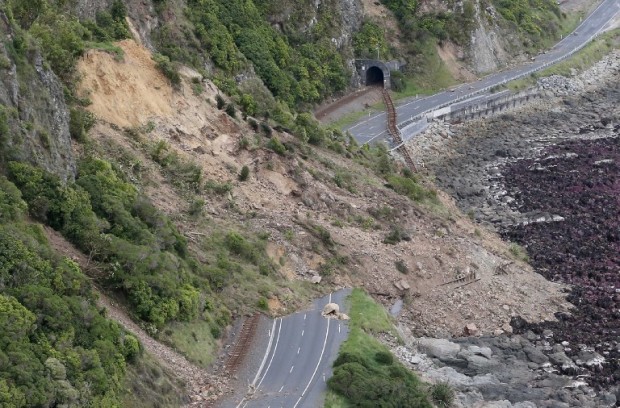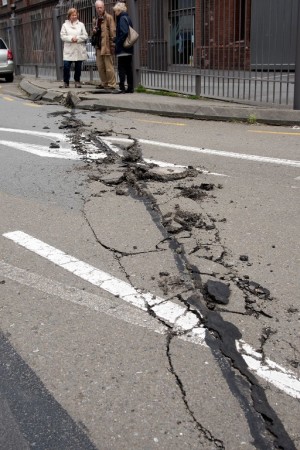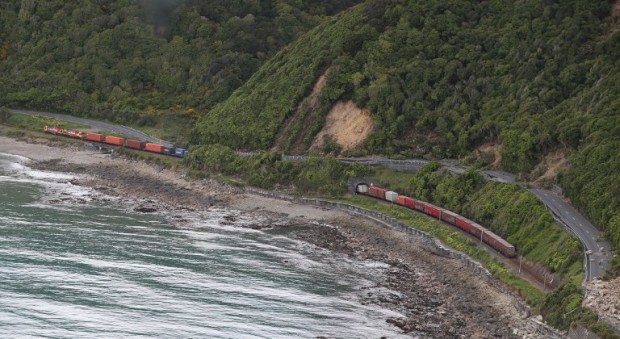Evacuations planned for quake-hit New Zealand

This aerial photo taken and received on November 14, 2016 shows earthquake damage to railway and to State Highway One near Ohau Point on the South Island’s east coast. A powerful 7.8-magnitude earthquake killed two people and caused massive infrastructure damage in New Zealand, but officials said on November 14 they were optimistic the death toll would not rise further. The jolt, one of the most powerful ever recorded in the quake-prone South Pacific nation, hit just after midnight near the South Island coastal town of Kaikoura. AFP
CHRISTCHURCH, New Zealand — Rescuers in New Zealand were scrambling Tuesday to evacuate up to 1,200 tourists stranded by a 7.8 earthquake that caused “utter devastation” on the coast of the South Island.
A navy ship was steaming towards the seaside town of Kaikoura, which bore the brunt of the quake that claimed two lives when it struck early Monday.
READ: New Zealand: Rescuers scramble to reach victims of 7.8 temblor | 2 die as powerful quake hits New Zealand, causing tsunami
Huge landslides have cut road and rail links to the town, where police say water is running low, power is intermittent and hundreds of people are staying in evacuation shelters.
It has a population of 2,000, which Prime Minister John Key said was bolstered by an extra 1,200 tourists attracted by the area’s popular whale-watching cruises.
He said four military helicopters would begin ferrying the trapped visitors, mostly international backpackers, in small groups to Christchurch from early Tuesday.
Naval ship HMNZS Canterbury would take hundreds more when it arrives, likely Wednesday, he added.

Members of the public inspect the damage to the road on the Wellington water front after a 7.8 earthquake centered in the South Island, in Wellington on November 14, 2016. AFP
Huge landslides have cut road and rail links to the town, where police say water is running low, power is intermittent and hundreds of people are staying in evacuation shelters.
Key estimated the quake repair bill would reach billions of dollars but the short-term priority was delivering much-needed supplies to the stricken town.
“It’s more water and food, it’s more chemical toilets, it’s fixing up the road access, getting those tourists out and then ultimately the big clean-up job,” he told TVNZ.
The Defense Force said a C-103 Hercules was also on standby to drop supplies, while state broadcaster Radio New Zealand reported up to 50 civilian helicopters could also be drafted into the tourist evacuation effort.
The Canterbury set off from Auckland late Monday and its commanding officer Simon Rooke said the ship could take up to 500 tourists.
“We’re going to pick them up by landing craft and sea boats and extract them to Lyttelton (in Christchurch) so they can get to a point of safety,” he said.
“We’re going to pick them up by landing craft and sea boats and extract them to Lyttelton (in Christchurch) so they can get to a point of safety,” he said.
Heavy rain and driving winds were hampering clean-up efforts, although life outside the main Kaikoura disaster zone was slowly returning to normal as roads opened and power was restored.
There have also been more than 800 aftershocks, some measuring more than 6.0, further complicating the work of emergency crews.
‘Absolutely terrified’
The tremor, one of the most powerful ever in the quake-prone South Pacific nation, hit just after midnight on Monday morning.
It triggered landslides that dumped mountains of rocky debris on a main highway and ripped railway tracks 10 meters (30 feet) off course.
Huge fissures opened up in roads and some houses were rocked off their foundations.
One person was believed to have died at a historic homestead that collapsed at Kaikoura, with another killed at a remote property north of Christchurch.
Experts said the relatively low death toll was because the quake was centered on a sparsely populated area and hit during the middle of the night, when people were in their homes.

A photo taken and received on November 14, 2016, shows a freight train partially buried by landslide near Kaikoura on the South Island’s east coast. AFP
The tremor ignited painful memories for residents in nearby Christchurch, which was devastated five years ago by a 6.3 tremor that killed 185 people.
It was felt across most of the country, causing severe shaking in the capital Wellington, about 250 kilometers (155 miles) away.
The tremor ignited painful memories for residents in nearby Christchurch, which was devastated five years ago by a 6.3 tremor that killed 185 people.
It also set off a tsunami alert, with sirens sounding and police and emergency workers going door to door to evacuate seaside properties.
While officials initially feared waves of up to five meters (16 feet), they only reached about two meters before the alert was lifted.
Key flew over the quake’s epicenter on Monday and said he was shocked to see such “utter devastation”.
“He’d never been in an earthquake in his life, so he was in the James Cook Hotel (in Wellington) absolutely terrified at what was happening.
The New Zealand leader admitted he was concerned that tourism, the country’s biggest export earner, would take a hit after images of the damage flashed around the world.
“People worry about earthquakes,” he said, recounting visiting Hungarian President Janos Ader’s experience of the latest tremor.
“He’d never been in an earthquake in his life, so he was in the James Cook Hotel (in Wellington) absolutely terrified at what was happening.”
Key said New Zealand’s strict construction codes meant its buildings were high quality and tourists’ chances of being caught in a tremor were “truthfully very low”.
The country is on the boundary of the Australian and Pacific tectonic plates, which form part of the so-called “Ring of Fire”, and experiences up to 15,000 tremors a year, mostly minor. CBB














